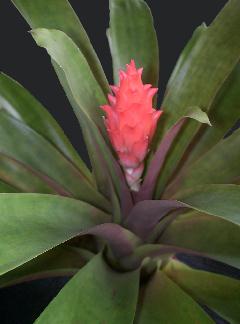
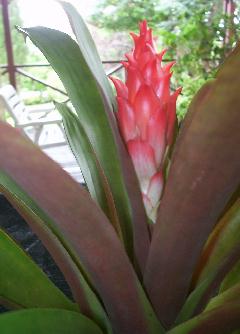
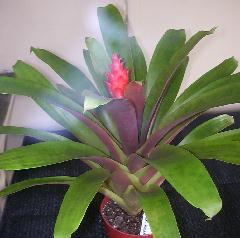
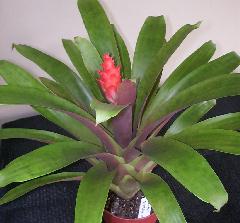
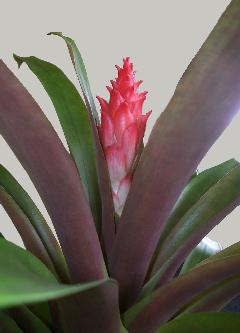
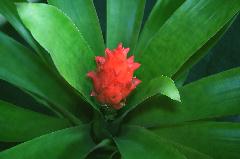
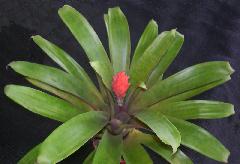
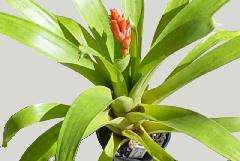
Descriptions supplied by Derek Butcher...
Guzmania osyana (E. Morren) Mez, DC. Monogr. Phan. 9: 914. 1896.
Caraguata osyana E. Morren, Belg. Hortic. 35: 254, pl. 16,17. 1885.
Caraguata magnifica hortus ex Baker, Handb. Bromel. 143. 1889; nomen.
Guzmania fusispica Mez & Sodiro, Bull. Herb. Boiss. II. 5: 112. 1905. see Binomials 10, 2006 Pers comm. From Manzanares to Luther
Guzmania recurvobracteata Rauh, Trop. Subtrop. Pflanzenwelt 31: 18-21. 1979 see Harry E. Luther in J. Brom. Soc. 35(6): 258, 277. 1985
Guzmania osyana (E. Morren) Mez, DC. Monogr. Phan. 9: 914. 1896.
Caraguata osyana E. Morren, Belg. Hortic. 35: 254, pl. 16,17. 1885.
Caraguata magnifica hortus ex Baker, Handb. Bromel. 143. 1889; nomen.
Desc from S&D
Plant stemless, flowering about 25 cm high.
Leaves about 40 in a dense spreading rosette, 45 cm long;
sheaths broadly ovate, brownish, covered especially above with minute brown scales;
blades ligulate, acute with a slender recurved apiculus, 4-5 cm wide, subglabrous, deep green with red lines above toward base.
Scape to 13 cm long, largely hidden by the leaves, straight, rather stout, glabrous;
scape-bracts straight, densely imbri¬cate, lanceolate, reddish.
Inflorescence very densely digitate from a few equal spikes, barely raised above the center of the rosette, globose, 8 cm in diameter;
primary bracts inconspicuous;
branches often rudimentary.
Floral bracts densely imbricate, broadly ovate with a triangular arching-recurved blade, to 55 mm long, 20 mm wide, coriaceous, bright orange-red;
flowers sessile, 42 mm long;
sepals elliptic, rounded, 30 mm long, connate for 2 mm, cartilaginous, smooth, lustrous, yellow;
petals yellow, the blades straight, broadly ovate, slightly emarginate;
stamens included.
Type. Wallis in Morren Hortus s n (holotype LG, GH photo), Ecuador, without exact locality, cultivated Mar 1884.
DISTRIBUTION. Known from the type collection only.
Guzmania fusispica Mez & Sodiro, Bull. Herb. Boiss. II. 5: 112. 1905.
Guzmania recurvobracteata Rauh, Trop. Subtrop. Pflanzenwelt 31: 18-21. 1979 see Harry E. Luther in J. Brom. Soc. 35(6): 258, 277. 1985
Desc from S&D
Plant stemless, flowering 35 cm high.
Leaves many in a dense rosette, 3 dm long;
sheaths ovate-elliptic, large, covered with castaneous scales;
blades linear, subrounded and apiculate, 30 mm wide, minutely brown-punctulate on both sides.
Scape erect, short, stout;
scape-bracts imbricate, the lower foliaceous but reduced, the upper bract-like, acuminate, involute.
Inflorescence simple, cylindric-fusiform, acute, 13 cm long, 25 mm in diameter, rather few-flowered, slightly sterile toward apex.
Floral bracts densely imbricate, exceeding the sepals, membranaceous, nearly white, subglabrous or punctulate lepidote, the lower abruptly acute, the others rounded;
flowers subsessile, strict, 50-75 mm long.
Sepals elliptic, slightly asymmetric and rounded at apex, ca 25 mm long, connate for 3 mm, subcoriaceous, even, glabrous;
petals yellow, agglutinated in a slender tube;
stamens included.
Type. Sodiro s n (holotype B, B photo 1206/30), San Nicolas, Pichincha, Ecuador, May 1886.
DISTRIBUTION. Forest, 1800 m alt, Ecuador.
ECUADOR. PICHINCHA: Tandapi, 26 Jun 1965, Naundorff s n (US).
Guzmania fusispica ; a Further Examination by Harry E. Luther in J. Brom. Soc. 35(6): 258, 277. 1985
The identity of Guzmania fusispica Mez & Sodiro has been difficult to determine because the type specimen, which is unnumbered, is very poor. While I have not seen the specimen itself, I have examined a U.S. National Herbarium photograph of it. Recent collections of a guzmania with pleated foliage and a simple yellow-flowered inflorescence from western Ecuador near the type locality of G. Fusispica are, however, almost certain to be of this species. In addition, G. recurvo-bracteata Rauh, which occurs in the same general area, is conspecific and should be reduced to synonomy.
Guzmania fusispica, apparently endemic to western Ecuador, shows a great deal of affinity to several other Ecuadorian guzmanias. especially G. Melinonis Regel. It resembles G. Melinonis in foliage and inflorescence coloration, but differs in the following characters:
G. Melinonis: Sepals ca. 15 mm long; floral bracts strict, erect to slightly incurved apically; scape usually longer than the leaf sheaths; native to lowland, wet forests on the eastern slopes of the Andes.
G. Fusispica: Sepals ca. 25 mm long; floral bracts recurved apically; scape usually shorter than the leaf sheaths; native to premontane rainforests on the western slopes of the Andes.
Guzmania fusispica has been collected from the provinces of Pichincha, Cotopaxi, and El Oro. Several specimens flower every June at the Marie Selby Botanical Gardens but do not thrive because of high summer temperatures. In contrast, G. Melinonis is well adapted to the hot, humid climate of Sarasota.
Guzmania fusispica, rarely found in cultivation, is usually misidentified as G. Strobilantha (Ruiz & Pavon) Mez, a totally dissimilar species from Peru.
Guzmania recurvo-bracteata RAUH sp. nov. Trop. Subtrop. Pflanzenwelt 31: 18-21. 1979
Planta acaulis, florens usque ad 30 cm alta; folia numerosa rosulam laxam infundibuliformem formantia; vaginae ellipticae, 13-18 cm longae, usque ad 7 cm latae, virides, basim versus brunnescentes, indistincte limitatae; laminae ligulatae, apice rotundatae mucronatae, usque ad 30 cm longae striis transversis irregularibus subtilibus; scapus inflorescentiae brevis, raro usque ad 15 cm longus, plerumque in axem rosulae immersus, glaber, albus; phylla scapi subfoliata, scapum omnino involventia, erecta, superiora alba vel pallide rufescentia; inflorescentia erecta, plerumque a foliis rosulae superata, simplex, breviter ellipsoidea, usque ad 10 cm longa, usque ad 5 cm crassa, multiflora; bracteae florales polysticha, 4-5 cm longa, 2 cm lata, basalia breviter viridi-acuminata, superiora obtusa, in triente superiore recurvata, cymbiformiter involuta, pallide cinnabarina vel punicea, basim versus albo- et rubro-striata; flores lutei a bracteis floralibus omnino obtecti; sepala libera, 1,5 cm longa, usque ad 9 mm lata, coriacea alutacea, apicem obtusum versus rufescentia, ecarinata, glabra; petala anguste lanceolata, 3,3 cm longa, usque ad medium connata et apicibus conniventia; stamina cum stylo inclusa.
Habitat: Ecuador centralis, in sylva montium inferiore (prope haciendam Selva negra iuxta viam antiquam Quito versus)
Holotypus : Rauh Nr. 34 472, in herb. inst. hot. system.univ.heidelb. (HEID)
Guzmania recurvo-bracteata RAUH spec. nov.
Plant stemless, flowering to 30 cm high; Leaves numerous, forming an open funnel-rosette ± 60 cm diam;
Leaf sheaths elliptic, 13-15 cm long, to 7 cm wide, green, brownish toward the base, indistinct;
Leaf blades ligulate, rounded at the top and short tipped, to 30 cm long, 4-5 cm wide, with fine, irregular cross lines;
Scape short, rarely to 15 cm long, usually sunk into the rosette axis; glabrous, white;
Scape bracts subfoliate, fully enclosing the scape, erect, the upper ones white to pale reddish, green tipped;
Inflorescence erect, usually exceeding the rosette leaves, simple, short-ellipsoid, to 10 cm long and to 5 cm thick, many flowered;
Floral bracts polystichous, 4-5 cm long, 2 cm wide, the bottom ones short green tipped, the upper ones blunt, the upper third bent over, sunken boat shaped, light cinnabar red to carmine red, towards the base white and red streaked;
Flowers yellow, covered completely by the floral bracts:
Sepals free, 1,5 cm long, to 9 mm wide, thick membranous, light brown, red towards the blunt tip, ecarinate, glabrous;
Petals narrow lanceolate, 3,3 cm long, 5 mm wide, joined up to the middle and cucculate at the top;
Stamens & stigma enclosed.
Habitat & Range: in the low mountain-forest of central-Ecuador, near Hacienda Selva negra, on the old road from Quito.
Holotype : RAUH Nr. 34 472, im (HEID).
The same species was found under the Collection number Rauh 38 069 near Santo Domingo (1200 m), west from Quito, where it grows with Guzmania melinonis var. quitensis Rauh( Bromelienstudien, 5. Mitt., S. 45ff., 1976). The Bromeliad specialist MR. PRINSLER has also collected it near Tanapi in central-Ecuador.
Guzmania recurvo-bracteata is in the complex found in French Guiana to Colombia, Ecuador and Bolivia in mountain and rain forests (from 400 to 1600 m) with the widely dispersed G. melinonis Regel ( Rauh, Bromelienstudien, 5. Mitt. and Trop. and Subtrop. Pflanzenwelt, 16, 1976, fig. 24 and 25, S. 248-249) from which it is difficult to distinguish vegetatively. Flowering clearly shows differences.
With G. melinonis the inflorescence is clearly ± bent over, ellipsoid to cylindrical; the floral bracts are erect, adjacent to the axis, shiny cinnabar red and green tipped. They have yellow (var. melinonis) or white (var. quitensis Rauh) flowers exceeding the floral bracts; with G. recurvo-bracteata the inflorescence is erect and thick-ellipsoid and floral bracts pale carmine red with white at the base with the upper third strongly bent outwards and folded in a boat shape. Only the basal floral bracts are short and green tipped, the upper ones are blunt. The yellow flowers are much shorter than the floral bracts and well covered by these. The inflorescence of G. recurvo-bracteata is more decorative than that from G. melinonis which has persisted in culture for so long.
There seems to be a link (or hybrid) between G. melinonis and G. recurvo-bracteata. In the area of Santo Domingo (1200 m), where the two varieties of G. melinonis, var. melinonis and var. quitenses occur, Rauh 38 069 was collected and already have flowered in the Heidelberg botanical garden several times. They have short, ellipsoid or long cylindrical spikes, 8-15 cm long, with spirally arranged (4-6-rows) floral bracts. They are variable, either wide-oval acuminate or lanceolate-oval acuminate. They are more or less erect and adjacent to the axis; only the intensively red coloured tips of the otherwise white bent over floral bracts can be seen easily. The yellow flower is like G. recurvo-bracteata fully covered by the floral bracts. Regrettably the black and white photo does not show the differences in colour of the floral bracts.
Whether it is a hybrid between G. melinonis and G. recurvobracteata, or a new species depends on a wider collection from the area.